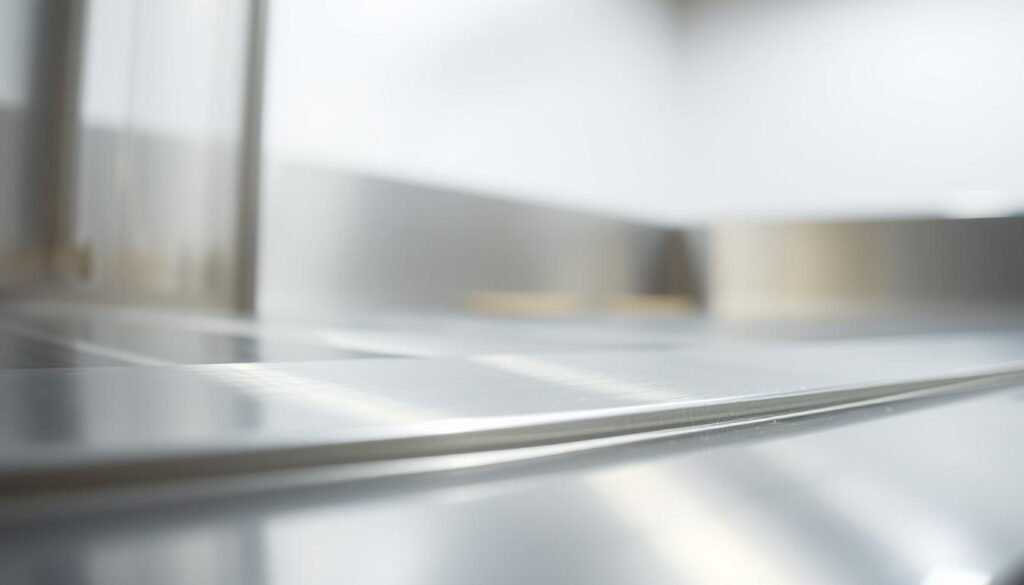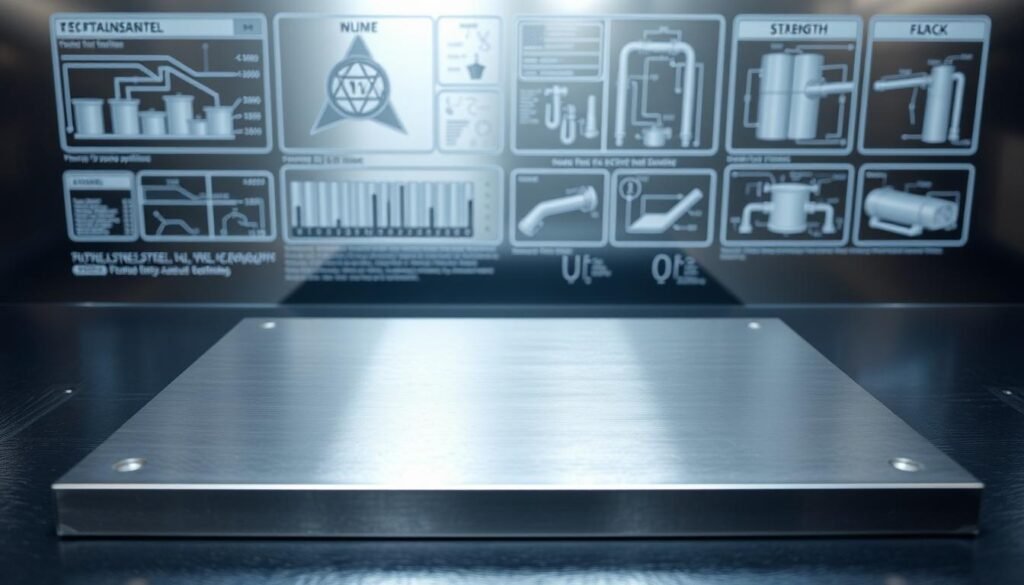Stainless steel is a versatile and widely used alloy in modern manufacturing and everyday applications.
It is not a single material but a family of iron-based alloys with specific compositions that provide unique properties, such as corrosion resistance and durability.
The importance of understanding the metals that make up stainless steel cannot be overstated, as different combinations create different grades of steel with varying properties.
This article will explore the main metals found in stainless steel and their significance in various industries.
Understanding Stainless Steel Composition
The characteristics of stainless steel that make it so valuable are a direct result of its carefully crafted composition. This alloy is not just a simple mixture of metals; it’s a precisely engineered material designed to offer exceptional performance in a wide range of applications.
The Definition of Stainless Steel
Stainless steel is defined as an alloy of iron, chromium, and, in some cases, nickel and other metals. With a minimum chromium content of 10.5%, it is continuously protected by a passive layer of chromium oxide that forms naturally on the surface. This layer regenerates itself if damaged, providing continuous protection against corrosion.
Why Metal Composition Matters
Understanding the metal composition of stainless steel is crucial for selecting the right type for specific applications. Different metal additions affect properties such as strength, ductility, weldability, and resistance to various environments. The composition determines whether a stainless steel is austenitic, ferritic, duplex, or martensitic, and it significantly impacts the cost, with certain alloying elements like nickel and molybdenum affecting the price.
What Metals Are in Stainless Steel
Stainless steel is a complex alloy composed of various metals, each contributing to its unique properties. The specific combination and proportion of these metals determine the alloy’s performance characteristics.

Iron: The Base Metal
Iron is the primary base metal in stainless steel, typically making up 50-70% of the alloy’s composition. It provides the fundamental strength and structure to the alloy.
Chromium: The Essential Element
Chromium is a critical component, with a minimum content of 10.5%, that forms a passive oxide layer, giving stainless steel its corrosion resistance. This layer protects the alloy from environmental factors that could cause degradation.
Nickel: Enhancing Corrosion Resistance
Nickel, typically present in amounts of 8-10% in common grades, enhances corrosion resistance in certain environments and improves the ductility and formability of steel. Its presence allows stainless steel to be used in a wider range of applications.
Other Important Metals and Elements
Other elements such as carbon, molybdenum, manganese, silicon, and nitrogen are added in smaller amounts to achieve specific property enhancements. For instance, molybdenum improves resistance to pitting and crevice corrosion, especially in chloride environments.
The Four Main Families of Stainless Steel
Understanding the four main families of stainless steel is crucial for selecting the right type for specific applications. Stainless steel is a versatile material used in various industries due to its corrosion resistance, strength, and aesthetic appeal.
Austenitic Stainless Steel
Austenitic stainless steel, also known as the 300 series, is the most common type. It contains 16-26% chromium and 6-26% nickel, offering excellent corrosion resistance and non-magnetic properties. Popular grades like 304 and 316 are widely used in food processing, kitchen equipment, and architectural applications due to their excellent formability and weldability.
Ferritic Stainless Steel
Ferritic stainless steel, or the 400 series, contains 10.5-30% chromium with little or no nickel. This composition makes them magnetic and more affordable but with moderate corrosion resistance. They are often used in applications where corrosion resistance is not the primary concern.
Duplex Stainless Steel
Duplex stainless steel has a mixed microstructure of austenite and ferrite, providing high strength and good corrosion resistance, particularly in chloride environments. This makes them ideal for use in harsh environments such as offshore oil and gas platforms.
Martensitic and Precipitation Hardening Stainless Steel
Martensitic stainless steel contains 11-17% chromium with higher carbon content, allowing them to be hardened through heat treatment for applications requiring wear resistance. Precipitation hardening stainless steels are specialty alloys that can be strengthened through aging treatments, making them suitable for aerospace and high-performance applications.
| Family | Composition | Properties | Applications |
|---|---|---|---|
| Austenitic | 16-26% Cr, 6-26% Ni | Excellent corrosion resistance, non-magnetic | Food processing, kitchen equipment, architectural |
| Ferritic | 10.5-30% Cr, little or no Ni | Magnetic, moderate corrosion resistance | Less demanding applications |
| Duplex | 21-26% Cr, 1-7% Ni | High strength, good corrosion resistance | Offshore oil and gas, chemical processing |
| Martensitic | 11-17% Cr, higher C content | Hardened through heat treatment | Wear-resistant applications |
How Metal Composition Affects Properties
The composition of metals in stainless steel significantly influences its overall properties. The presence of various elements such as chromium, nickel, and molybdenum plays a crucial role in determining its characteristics.
Corrosion Resistance
Stainless steel’s corrosion resistance is primarily due to its chromium content. With a minimum of 10.5% chromium, a passive layer of chromium oxide forms, protecting the steel. Increasing chromium content beyond this minimum progressively improves corrosion resistance in various environments. Additionally, nickel enhances resistance to acids, while molybdenum improves resistance to pitting and crevice corrosion in chloride environments.
- Chromium content enhances the formation of a protective oxide layer.
- Nickel improves resistance to acidic environments.
- Molybdenum reduces the risk of pitting and crevice corrosion.
Mechanical Properties
Stainless steel exhibits strong mechanical properties at ambient temperatures, combining ductility, elasticity, and hardness. The balance of ferrite-forming elements like chromium and molybdenum, and austenite-forming elements like nickel and nitrogen, determines its microstructure and resulting properties. Carbon content affects mechanical strength but can reduce corrosion resistance if not properly controlled during welding and heat treatment.

Magnetic Response
The composition of stainless steel also affects its magnetic response. Ferritic and martensitic stainless steels are magnetic, whereas fully austenitic grades are non-magnetic. The balance between ferrite-forming and austenite-forming elements influences this property.
- Ferritic and martensitic stainless steels exhibit magnetic properties.
- Fully austenitic stainless steels are non-magnetic.
The Manufacturing Process of Stainless Steel
The production of stainless steel involves a complex process that requires precise control over the composition and processing of the material. This process is crucial for achieving the desired properties of stainless steel, such as its corrosion resistance and durability.
Melting and Mixing the Metals
The manufacturing process begins with melting scrap metals and additives in an electric arc furnace (EAF) at temperatures exceeding 2500°F. The EAF uses high-power electrodes to heat the metals over several hours, creating a molten mixture. Notably, stainless steel is 100% recyclable, and many production orders include up to 60% recycled steel.
Carbon Content Control
Carbon content is a critical factor in stainless steel production. While carbon increases the hardness and strength of iron, excessive carbon can lead to issues like carbide precipitation during welding. To control carbon content, foundries use either Argon Oxygen Decarburization (AOD) or Vacuum Oxygen Decarburization (VOD) processes.
Forming and Finishing
After melting and carbon content control, the molten steel is cast into slabs, blooms, or billets. These are then subjected to hot and cold rolling to achieve the desired dimensions. The steel undergoes annealing, a process involving controlled heating and cooling cycles to relieve internal stresses. Finally, descaling, pickling, and surface treatments are applied to enhance corrosion resistance and appearance.
| Process Stage | Description | Key Outcome |
|---|---|---|
| Melting and Mixing | Scrap metals and additives melted in EAF | Molten stainless steel mixture |
| Carbon Content Control | AOD or VOD processes used | Optimal carbon content achieved |
| Forming and Finishing | Casting, rolling, annealing, and surface treatments | Desired dimensions and corrosion resistance |
Conclusion
With its complex alloy composition, stainless steel offers a broad spectrum of properties suitable for various industries. The key metals found in stainless steel include iron as the base, chromium (minimum 10.5%) for corrosion resistance, and varying amounts of nickel, molybdenum, and other elements for specific properties.
The four main families of stainless steel – austenitic, ferritic, duplex, and martensitic – offer different combinations of properties to suit various applications. Understanding stainless steel composition is crucial for selecting the right grade for specific requirements in terms of corrosion resistance, strength, formability, and cost.
The manufacturing process, particularly carbon content control and heat treatment, plays a significant role in determining the final properties of steel. As stainless steel continues to evolve with new grades being developed, consulting with materials experts is essential for optimal performance and longevity in critical applications.
